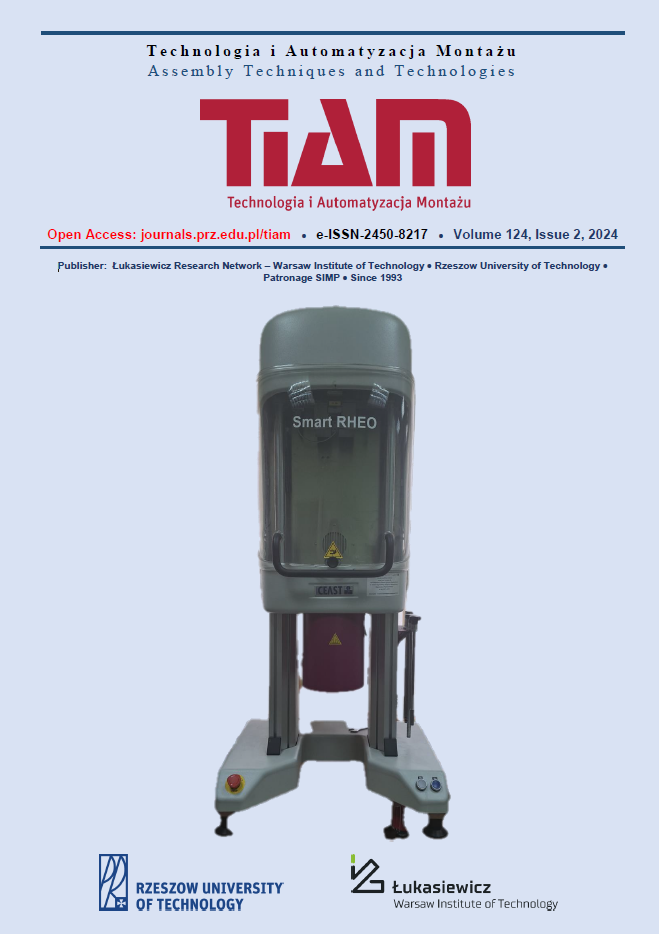Abstract
High joint strength of composite structures can be achieved by using mechanical fasteners. The materials used for rivets and bolts have lower coefficients of thermal expansion than composites in the direction perpendicular to the reinforcement fibers. It is suspected, therefore, that temperature changes can cause stress changes in mechanical fasteners. The purpose of this study was to experimentally determine and analytically substantiate the values of stress changes resulting from a change in temperature in the range from -20 to 60°C in M8 steel bolts fastening carbon composite. The value of stress changes was estimated to be around 100 MPa, which can consequently lead to joint unsealing or plastic deformation of the mechanical fastener.
References
Arkuszyńska A., Godzimirski J., Rośkowicz M. (2023). Analysis of the properties of orthotropic composites in terms of their use in airframe repairs. Technologia i Automatyzacja Montażu 121, 3-12.
Bolanowski K. (2013). Właściwości wytrzymałościowe oraz zmiany morfologii mikrostruktury stali mikrostopowej w warunkach pełzania. Monografie, Studia, Rozprawy (Wydawnictwo Politechniki Świętokrzyskiej) 39.
Carlsson L.A., Adams D. F., Pipes B. R. (2013). Basic Experimental Characterization of Polymer Matrix Composite Materials. Polymer Review 53, 277-302.
Cavalcanti W. L., Brune K., Noeske M., Tserpes K., Ostachowicz W. M., Schlag M. (2021). Adhesive Bonding of Aircraft Composite Structures. Non-destructive Testing and Quality Assurance Concepts. Cham: Springer.
DeFu L., YongJun T., Cong W.L. (2012). A review of mechanical drilling for composite laminates. Composite Structures 94, 1265-1279.Dipen R. K., Durgesh P. D., Ravinder K., Catalin P. I. (2019). Recent progress of reinforcement materials: a comprehensive overview of composite materials. Journal of Materials Research and Technology 8(6), 6354-6374.
Donglin G., Zuguo B., Weijian H., Xianpeng W., Shiyao H., Li H., Qiuren Ch., Hailong Z., Yahong X. (2023). Effect of Strain Rate on Tensile Properties of Carbon Fiber-Reinforced Epoxy Laminates with Different Stacking Sequences and Ply Orientations. Polymers 15, 2711.
Emanoil L., Dipen R. K., Durgesh P. D., Pradeep M. L. (2019). Fiber-Reinforced Polymer Composites: Manufacturing, Properties, and Applications”. Polymers 11(10), 1667
Fernández-Pérez J., Cantero J. L., Díaz-Álvarez J., Miguélez M. H. (2017). Influence of cutting parameters on tool wear and hole quality in composite aerospace components drilling. Composite Structures 178, 157-161.
Gamdani F., Boukhili R., Vadean A. (2022). Fatigue behavior of hybrid multi-bolted-bonded single-lap joints in woven composite plates. International Journal of Fatigue 158, 106738.
Gaugel S., Sripathy P., Haeger A., Meinhard D., Bernthaler T., Lissek F., Kaufeld M., Knoblauch V., Schneider G. (2016). A comparative study on tool wear and laminate damage in drilling of carbon-fiber reinforced polymers (CFRP). Composite Structures 155, 173-183.
Goertzen W. K., Kessler M. R. (2006). Creep behavior of carbon fiber/epoxy matrix composites. Materials Science and Engineering A 421, 217–225.
Higgins A. (2000). Adhesive bonding of aircraft structures. International Journal of Adhesion & Adhesives 20, 367-376.
Hull D., Clyne T. W. (1996). An Introduction to Composite Materials. Cambridge: Cambridge University Press.
Kamali G., Ashokkumar N., Sugash K., Magesh V. (2017). Advanced Composite Materials of the Future in Aerospace Engineering. International Journal for Research in Applied Science & Engineering Technology 5, 610-614.
Kaufmann M., Zenkert D., Wennhage P. (2009). Integrated cost/weight optimization of aircraft structures. Structural and Multidisciplinary Optimization 41(2), 325-334.
Mandalgiri P. D. (1999). Composite Materials for Aerospace Applications. Bulletin of Materials Science 22(3), 657-664.
Nabil V., Reyes L. A., Hernández-Muñoz G.M., Zambrano-Robledo P. (2016). Parametric Effects in Hybrid Lap Joints of Composite Materials Used in Aircraft Structures. W Proceedings of the Symposium of Aeronautical and Aerospace Processes, Materials and Industrial Applications. Springer.
Ochelski S. (2004). Metody doświadczalne mechaniki kompozytów konstrukcyjnych. Warszawa: Wydawnictwa Naukowo-Techniczne.
Ochelski S., Gotowicki P. (2007). Doświadczalna ocena zdolności pochłaniania energii kompozytów węglowo-epoksydowych i szklano-epoksydowych. Biuletyn WAT LVI(1), 143-158.
Ochelski S., Gotowicki P. (2008). Experimental Support for Numerical Simulations of Energy Absorbing Structures. Journal of KONES Powertrain and Transport 15(1), 183-217.
Ornaghi H. L., Almeida J. H. S., Monticeli F. M., Neves R. M., Cioffi M. O. H. (2021). Time-temperature behavior of carbon/epoxy laminates under creep loading. Mech Time-Depend Mater 25, 601–615.
Tomkinson G. (1991). Hi-Lok and Hi-Lok/Hi-Tigue Fasteners Installations Instructions. Hi-Shear Corporation.
Vol’mir A. S., Pavlenko V. F., Ponomarev A. T. (1972). Use of composite materials in airframes. Polymer Mechanics 8, 89-95.
Yanishevsky M., Gang L., Shi G., Backman D. (2013). Fractographic examination of coupons representing aircraft structural joints with and without hole cold expansion. Engineering Failure Analysis 30, 74-90.


